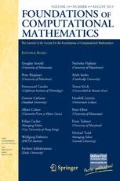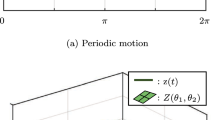Abstract
We introduce a new methodology to design uniformly accurate methods for oscillatory evolution equations. The targeted models are envisaged in a wide spectrum of regimes, from non-stiff to highly oscillatory. Thanks to an averaging transformation, the stiffness of the problem is softened, allowing for standard schemes to retain their usual orders of convergence. Overall, high-order numerical approximations are obtained with errors and at a cost independent of the regime.





Similar content being viewed by others
Notes
Note, however, that this series is convergent for a linear right-hand side in (1.1) with bounded operator and for all sufficiently small \(\varepsilon \).
To facilitate the convergence of the fixed-point iterations for large \(\varepsilon \), for all \(\varepsilon \) one can multiply \(g_\theta \) in (4.3) or \(h_\theta \) in (4.11) by a damping term such as \(\exp ({-\varepsilon ^2})=1+{\mathcal {O}}(\varepsilon ^2)\) which does not affect the uniform accuracy of order two.
Indeed, it can be shown that the local error and hence the global error of order two of the integral schemes \(S^\mathrm{RK2}_{\Delta t}\) and \(S^\mathrm{midpoint}_{\Delta t}\) applied to any system \(\dot{y}=f(t,y)\) involves only the norms of the second-order derivative \(\ddot{y}\) of the solution and the derivatives \(\partial _t f,\partial _y f,\partial _{yy} f,\partial _{yt} f\) of the vector field, and in contrast to a standard Runge–Kutta method, it does not depend on \(\dddot{y},\partial _{tt} f\).
This discretization turns out to be exact for the Hénon–Heiles problem, due to the low degree of the involved trigonometric polynomials.
References
W. Bao and X. Dong. Analysis and comparison of numerical methods for the Klein-Gordon equation in the nonrelativistic limit regime. Numer. Math., 120(2):189–229, 2012.
S. Baumstark, E. Faou, and K. Schratz. Uniformly accurate exponential-type integrators for Klein-Gordon equations with asymptotic convergence to the classical NLS splitting. to appear in Math. Comp., 2017.
M. P. Calvo, P. Chartier, A. Murua, and J. M. Sanz-Serna. Numerical stroboscopic averaging for ODEs and DAEs. Appl. Numer. Math., 61(10):1077–1095, 2011.
F. Castella, P. Chartier, F. Méhats, and A. Murua. Stroboscopic averaging for the nonlinear Schrödinger equation. Found. Comput. Math., 15(2):519–559, 2015.
P. Chartier, N. Crouseilles, M. Lemou, and F. Méhats. Uniformly accurate numerical schemes for highly oscillatory Klein-Gordon and nonlinear Schrödinger equations. Numer. Math., 129(2):211–250, 2015.
P. Chartier, M. Lemou, and F. Méhats. Highly-oscillatory evolution equations with multiple frequencies: averaging and numerics. Numer. Math., 136(4):907–939, 2017.
P. Chartier, J. Makazaga, A. Murua, and G. Vilmart. Multi-revolution composition methods for highly oscillatory differential equations. Numer. Math., 128(1):167–192, 2014.
P. Chartier, A. Murua, and J. M. Sanz-Serna. Higher-order averaging, formal series and numerical integration I: B-series. Found. Comput. Math., 10(6):695–727, 2010.
P. Chartier, A. Murua, and J. M. Sanz-Serna. Higher-order averaging, formal series and numerical integration II: The quasi-periodic case. Found. Comput. Math., 12(4):471–508, 2012.
P. Chartier, A. Murua, and J. M. Sanz-Serna. Higher-order averaging, formal series and numerical integration III: error bounds. Found. Comput. Math., 15(2):591–612, 2015.
N. Crouseilles, M. Lemou, and F. Méhats. Asymptotic preserving schemes for highly oscillatory Vlasov-Poisson equations. J. Comput. Phys., 248:287–308, 2013.
E. Faou and K. Schratz. Asymptotic preserving schemes for the Klein-Gordon equation in the non-relativistic limit regime. Numer. Math., 126(3):441–469, 2014.
E. Hairer, C. Lubich, and G. Wanner. Geometric numerical integration, volume 31 of Springer Series in Computational Mathematics. Springer-Verlag, Berlin, second edition, 2006. Structure-preserving algorithms for ordinary differential equations.
M. Hénon and C. Heiles. The applicability of the third integral of motion: Some numerical experiments. Astronom. J., 69:73–79, 1964.
S. Machihara. The nonrelativistic limit of the nonlinear Klein-Gordon equation. Funkcial. Ekvac., 44(2):243–252, 2001.
S. Machihara, K. Nakanishi, and T. Ozawa. Nonrelativistic limit in the energy space for nonlinear Klein-Gordon equations. Math. Ann., 322(3):603–621, 2002.
N. Masmoudi and K. Nakanishi. From nonlinear Klein-Gordon equation to a system of coupled nonlinear Schrödinger equations. Math. Ann., 324(2):359–389, 2002.
L. M. Perko. Higher order averaging and related methods for perturbed periodic and quasi-periodic systems. SIAM J. Appl. Math., 17:698–724, 1969.
G. R. W. Quispel and D. I. McLaren. A new class of energy-preserving numerical integration methods. J. Phys. A, 41(4):045206, 7, 2008.
J. A. Sanders and F. Verhulst. Averaging methods in nonlinear dynamical systems, volume 59 of Applied Mathematical Sciences. Springer-Verlag, New York, 1985.
Acknowledgements
This work was partially supported by the Swiss National Science Foundation, Grants No. 200020_144313/1 and 200021_162404 and by the ANR Project Moonrise ANR-14-CE23-0007-01.
Author information
Authors and Affiliations
Corresponding author
Additional information
Communicated by Christian Lubich.
Publisher's Note
Springer Nature remains neutral with regard to jurisdictional claims in published maps and institutional affiliations.
Appendix
Appendix
This section is devoted to the proof of Proposition 3.2 and Theorem 3.3. We first recall the two following basic results from [4]:
Lemma A.1
(See Castella et al. [4]) Let \(0< \delta < \rho \le 2R\). Assume that the function \((\theta ,u) \in {\mathbb {T}}\times \mathcal{K}_\rho \mapsto \varphi _\theta (u) \in X_{\mathbb {C}}\) is analytic, and that \(\varphi _\theta \) is a near-identity mapping, in the sense that
Then \(\Vert \partial _u \varphi \Vert _{\rho -\delta } \le \frac{3}{2}\), the mapping \(\partial _u \langle \varphi \rangle ^{-1}\) is well defined and analytic on \(\mathcal{K}_{\rho -\delta }\) with \(\Vert \partial _u \langle \varphi \rangle ^{-1} \Vert _{\rho -\delta } \le 2\), and the mappings \((\theta ,u) \in {\mathbb {T}}\times \mathcal{K}_{\rho -\delta } \mapsto \Lambda (\varphi )_{\theta }(u)\) and \((\theta ,u) \in {\mathbb {T}}\times K_{\rho -\delta } \mapsto \Gamma ^\varepsilon (\varphi )_{\theta }(u)\) are well defined and analytic. In addition, the following bounds hold for all \(\varepsilon \ge 0\),
Lemma A.1 shows that starting from a function \((\theta ,u) \in {\mathbb {T}}\times \mathcal{K}_{2R} \mapsto \varphi _\theta (u) \in X_{\mathbb {C}}\), we can consider iterates \(\left( \Gamma ^\varepsilon \right) ^k (\varphi )_\theta \) at the cost of a gradual thinning of their domains of analyticity. The following contraction property holds.
Lemma A.2
(See Castella et al. [4]) Let \(0< \delta < \rho \le 2R\) and consider two periodic, near-identity mappings \((\theta ,u) \in {\mathbb {T}}\times \mathcal{K}_\rho \mapsto \varphi _\theta (u)\) and \((\theta ,u) \in {\mathbb {T}}\times \mathcal{K}_\rho \mapsto {\tilde{\varphi }}_\theta (u)\), analytic on \(\mathcal{K}_\rho \) and satisfying
Then, the following estimates hold for all \(\varepsilon \ge 0\),
Proof of Proposition 3.2
We assume that all \(\Phi ^{[k]}\) are defined by (2.4) in the stroboscopic case (all functions \(G^{[k]}\) are taken null). The following properties were already proved in [4]:
- (i)
the maps \(\Phi ^{[k]}\) and \(F^{[k]} := \langle \partial _u \Phi ^{[k]} \rangle ^{-1} \langle f \circ \Phi ^{[k]} \rangle \) are well defined and analytic on \(K_{R_k}\) for all \(k=0,\ldots ,n+1\);
- (ii)
the estimates,
$$\begin{aligned} \left\| \Phi ^{[k]}-\mathrm{id}\right\| _{R_{k}}&\le \frac{r_n}{2}, \quad \left\| F^{[k]}\right\| _{R_{k+1}} \le 2M \; \text{ and } \; \left\| \Phi ^{[k+1]}-\Phi ^{[k]}\right\| _R \\&\le C \left( 2 (n+1) \frac{\varepsilon }{\varepsilon _0} \right) ^k, \end{aligned}$$hold for some positive constant C independent of n, k and \(\varepsilon \).
From Eq. (2.4) with \(G^{[k+1]} \equiv 0\) and Assumption 3.1, it is obvious that \(\Phi ^{[k]}\) is \((p+1)\) times continuously differentiable w.r.t. \(\theta \). We have furthermore, for \(0 \le k \le n\)
so that, by differentiating \(\nu \le p\) times w.r.t. \(\theta \) with the help of the Leibniz and the Faà di Bruno formulae, we obtain
where the inner sum runs over multi-indices \(\mathbf{i}=(i_1,\ldots ,i_q) \in {\mathbb {N}}^q\) such that \(i_1+2i_2+\ldots +qi_q=q\) and where \(|\mathbf{i}|=i_1+\cdots +i_q\) and
Owing to (ii), for \(u \in \mathcal{K}_{R_{k+1}}\), \(\Phi ^{[k]}_\theta (u)\) takes its values in \(\mathcal{K}_{R_{k+1}+r_n/2}\), a set on which \(\partial _\theta ^j \partial _u^i f_\theta \) is bounded (due to Assumption 3.1 and Cauchy estimates for analytic functions) as follows:
Hence, if we denote \(\alpha _{k,\nu }=\Vert \partial ^\nu _\theta \Phi ^{[k]}\Vert _{R_k}/(\varepsilon M)\), for \(\nu \ge 1\), then we have
where we denote \(\alpha _k^\mathbf{{i}} =\prod _{j=1}^q \alpha _{k,j}^{i_j}\) and use that (owing to (ii) and a Cauchy estimate)
Finally, the assumption that \((n+1) \varepsilon \le \varepsilon _0 = \frac{R}{8M}\) leads to the inequality
We now introduce the generating functions for \(\xi \in {\mathbb {C}}\),
A direct estimation gives \(\alpha _{1,1} \le 2\) and \(\alpha _{1,\nu } \le 1\) for \(\nu \ge 2\), so that \(0 \le g_1(\xi ) \le \xi +e^\xi -1\) for all \(\xi \in {\mathbb {R}}_+\) and from (A.1), we obtain (owing to the Leibniz and the Faà di Bruno formulae)
where
so that, using \(\alpha _{k+1,1} \le 4\), we have for \(\xi \in {\mathbb {R}}_+\)
Noticing that \(\sup _{0 \le \xi \le 1} g_k(\xi ) = g_k(1)\), the previous inequality leads to
and an easy induction shows that the sequence \((g_k(1))_{k \ge 1}\) is upper bounded by 8. We conclude the proof by applying Cauchy estimates as follows:
\(\square \)
Proof of Lemma 3.4
Under assumptions (3.9), it has been shown in [4] that:
- (a)
\(\Vert \partial _u \varphi \Vert _{\rho -\delta } \le \frac{3}{2}\), the mapping \( \langle \partial _u \varphi \rangle ^{-1}\) is analytic on \(\mathcal{K}_{\rho -\delta }\) and obeys \(\Vert \langle \partial _u \varphi \rangle ^{-1} \Vert _{\rho -\delta } \le 2\);
- (b)
the mappings \(\Lambda (\varphi )_{\theta }(u)\) and \(\Gamma ^\varepsilon (\varphi )_{\theta }(u)\) are analytic on \(\mathcal{K}_{\rho -\delta }\) for all \(\theta \in {\mathbb {T}}\), and
$$\begin{aligned} \forall 0< \varepsilon < \varepsilon _0, \quad \Vert \Lambda (\varphi )\Vert _{\rho -\delta } \le 4 \, M \quad \text{ and } \quad \Vert \Gamma ^\varepsilon (\varphi ) - \mathrm{Id}\Vert _{\rho -\delta } \le 4 \, M \, \varepsilon . \end{aligned}$$
Now, on the one hand, for a multi-index \(\mathbf{i}=(i_1,\ldots ,i_q) \in {\mathbb {N}}^q\), the algebraic identity
leads, for any \((\Delta _1, \ldots , \Delta _q) \in X_{{\mathbb {C}}}^q\) and any \(({\tilde{\Delta }}_1, \ldots , {\tilde{\Delta }}_q) \in X_{{\mathbb {C}}}^q\), to
On the other hand, the Faà di Bruno’s formula with \(1 \le \nu < p\) gives
with the notations of Theorem 3.2. Hence, using the decomposition in (A.2) we have
Upon using Cauchy estimates, we obtain
where we denote \({\tilde{C}}_\mathbf{i}^q = C_\mathbf{i}^q \; \prod _{j=1}^q j!^{i_j}\) and
Considering now the second part of \(\partial _\theta ^\nu (\Lambda (\varphi )_\theta -\Lambda ({\tilde{\varphi }})_\theta )\) and denoting \(F=\langle \partial _u \varphi \rangle ^{-1} \langle f \circ \varphi \rangle \) and \({\tilde{F}}=\langle \partial _u {\tilde{\varphi }} \rangle ^{-1} \langle f \circ {\tilde{\varphi }} \rangle \), we have for \(\nu \ge 1\)
Denoting \(A_\theta (u)=\partial _u \varphi _{\theta }(u)\) and \({\tilde{A}}_\theta (u)=\partial _u {\tilde{\varphi }}_{\theta }(u)\), we have
where we have used the bound in (a) \(\Vert \langle A\rangle ^{-1}\Vert _{\rho -\delta } \le 2\), \(\Vert \langle {\tilde{A}}\rangle ^{-1}\Vert _{\rho -\delta } \le 2\) and the inequality
Finally, we obtain
Collecting all terms, we finally have
with \(Q_\nu (\xi ) = 1+2 \xi + P_\nu (\xi )\). By a Cauchy estimate, it holds that
The corresponding bound for \(\Gamma ^\varepsilon \) is then obtained straightforwardly. \(\square \)
Rights and permissions
About this article
Cite this article
Chartier, P., Lemou, M., Méhats, F. et al. A New Class of Uniformly Accurate Numerical Schemes for Highly Oscillatory Evolution Equations. Found Comput Math 20, 1–33 (2020). https://doi.org/10.1007/s10208-019-09413-3
Received:
Revised:
Accepted:
Published:
Issue Date:
DOI: https://doi.org/10.1007/s10208-019-09413-3
Keywords
- Highly oscillatory problems
- Stroboscopic averaging
- Standard averaging
- Micro–macro method
- Pullback method
- Uniform accuracy




